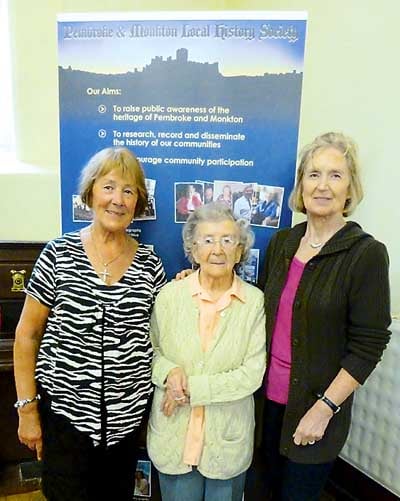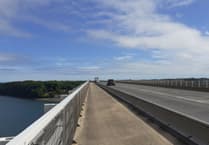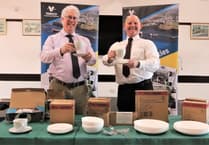Our speaker recently was Craig Stringer, of Pembrokeshire Coast National Park, who came to speak to us about the History of the Castlemartin Tank Range. We have come to make the Castlemartin Range an annual event each May and, such is the interest that it always proves popular. Craig is well-known to us in the History Society as he has taken us previously on a tour of the Farmsteads of the Castlemartin Tank Range, a rare opportunity to see buildings and a seascape which are normally out of bounds. Access is permitted occasionally, but only on a conducted tour or guided walk.
Flimston Chapel
Craig began by talking about Flimston Chapel. There has been a chapel here from medieval times, and it is one of the few surviving buildings left on the ranges. It fell into disuse in the 18th century and was converted into a cart shed, but later rescued and restored by Colonel Francis and Lady Victoria Lambton, of Brownslade, as a memorial to their three sons who were killed in the Boer War. Theirs is a sad story, and one can only imagine how heartbreaking it must have been to lose three sons in the space of a year (1899-1900). It is a beautiful little church and the marble monument to Alexander Frederick, William Francis and Ronald Robert, is displayed there. As if this sacrifice were not enough, yet another son, Edward, was to die in World War One. Denis Alderman has written about the family in his book entitled 'Fit to keep company with...' the Lambtons, of Brownslade. I bought my copy from the lovely community café at Castlemartin - (if you haven't tried it, I can certainly recommend it). Denis is also the author of 'Castlemartin...a chuckle and a cackle.' These books are a must for anyone interested in the history of this area. The church was further restored by the German Army in 1970 and occasional services are still held here.
Flimston and Pricaston
Nearby stands the shell of Flimston Farm destroyed by the Army with little heed that this was a medieval building, Craig ventured the opinion that it is probably contemporary with Carew Castle. Before the requisition, the farm was owned by the family of May Roberts - in 1939 her parents were given 6 months notice but fortunately they were able to take over a 270 acre farm at Orielton - others were not so fortunate and had to leave the land they loved to farm elsewhere. Flimston was once a large, productive farm with extensive buildings and the photograph here will give you some idea of that. Likewise, Pricaston, the next stop on the tour. Again, we are looking at a medieval building with a vaulted undercroft with additions made over time. Its biggest expansion was in the 18th century when it became a very grand house boasting of a Chippendale staircase. Now, like Flimston, it is a roofless shell of a building, although it is still possible to imagine how impressive it once was.
1970s Destruction
Craig informed us that the greatest damage was not inflicted during the war years: until 1973 most of the buildings were intact. However, at that time, the Army decided that it might move its artillery from Bovington in Dorset and made a survey of the Castlemartin Range. In order to make room, they blew up all the buildings and only then, after inflicting such terrible damage, did the Army change its mind and decide against the intended move. Brownslade fared worse and was completely obliterated. No account was taken of its historical importance.
John Mirehouse and John Campbell
Craig gave an interesting account of the transformation of Brownslade into a model farm. It was all down to John Mirehouse (a name we are all familiar with) who became friendly with John Campbell, who later became Lord Campbell and inherited the Stackpole Estate. In 1784, he offered John Mirehouse the lease of Brownslade and also built a new grand house for the farm. John Mirehouse landscaped the surrounding land, made extensive walled gardens and constructed a model set of farm buildings. He was extremely able, and energetically set about modernising which included the construction of a piped water supply and drainage system, thereby creating productive, arable land. He was very successful, too much so perhaps as it would seem he aroused a certain amount of suspicion in Lord Cawdor's mind, rumours were spread and the two friends fell out. The upshot was that John Mirehouse left and went to Angle. The farm buildings and walled gardens can still be seen. They are extensive and it is a great shame to see such neglect: I think that reclaiming the lost gardens could be a wonderful project, and could be a great attraction. The Lambtons
Following John Mirehouse, the Lambtons came to Brownslade and they extended the house. Lady Victoria Lambton was very well-liked in the district apparently, she took her duties seriously and did much community work. Such was the importance of Brownslade that King Edward VII, Queen Alexandria and Princess Victoria came visiting on Saturday, August 2, 1902, and took lunch with the Lambtons. The menu survives. I had a copy of this from Gordon Smith who, last year, gave us a presentation of photographs of the Castlemartin area. The royal party had a choice of fried fillets of sole, darioles de volaille, lamb cutlets in aspic and mayonnaise of chicken. Or, sweetbreads braised, roast chicken, fillets of beef sauté, accompanied by French beans a la fricassee and peas in fresh butter with lobster and salads. For dessert, the royal guests could choose from genoese pastry, almond pastry, peach tarts, plums in syrup with cream ice and coffee. After lunch, King Edward expressed a wish to see some of the famous Castlemartin black cattle, so about thirty of these fine creatures belonging to Mr. Thomas, of Bulliber, were driven on to the lawn in front of their Majesties.
A magnificent coast
The royal party then proceeded to take a look at Stack Rocks and St. Govans and completed their tour of the area at Stackpole Court. Craig finished his talk with a look at this magnificent coastline, the cliffs at Linney Head being the highest in Pembrokeshire and certainly the most dramatic. Here too was located an Iron Age fort dating back some 3,200 years, and apparently, Craig informed us, there has been a reappraisal of the function of these forts, not military, but spiritual, a place of transition to the next world. Interesting stuff and I often feel that there is a strong feeling of spirituality here with its standing stones and many burial grounds.
Summer time
This talk concludes our spring programme and we will recommence our programme of events next September. However, we are still active, supporting Pembroke Museum in Pembroke Town Hall which is now open five mornings per week, from 10 am to 12.30 pm. Anyone wanting to volunteer and get involved will be welcome. We will also be involved in various local events and exhibitions throughout the summer.
Contact
If you have any stories, photographs or feedback for this column, please contact me, Linda Asman, on 01646 622428, email [email protected]">[email protected] and visit our website http://www.pembrokeandmonkonhistory.org.uk">www.pembrokeandmonkonhistory.org.uk





Comments
This article has no comments yet. Be the first to leave a comment.